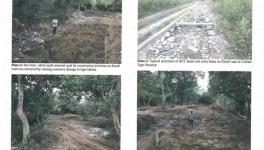How Modi Government is Playing Havoc With Nature

The statistics are chilling. A study conducted by the Indian Institute of Technology, Delhi, the Indian Statistical Institute and the Institute of Atmospheric Studies, in 640 districts has found that high Particulate Matter-2.5 (PM 2.5) levels reduce the height of young children and their overall physiological development. This study, conducted among 225,000 children, should warn Indian policymakers about the dangers inherent to chopping down forests at the present alarming rate.
The warning signs are everywhere: The Energy Policy Institute at the University of Chicago, which developed the Air Quality Life Index informs us that on average, people live 4.3 years longer if their country has clean air. The 2017 India State Level Disease Burden Initiative, published in medical journal The Lancet pegged fatalities in India due to air pollution at 1.24 million, or 12.5% of total deaths.
Fifteen out of 20 most polluted cities of the world are in India. One would have thought that ensuring the good health and well-being of citizens would be top priority for any government. Unfortunately, the business-friendly policies being pursued by the National Democratic Alliance (NDA) government led by Prime Minister Narendra Modi are only going to do the opposite: exacerbate a health crisis.
The statistics speak for themselves. In the last five years, the National Board of Wildlife has cleared 500 projects in protected areas. Between 2009 and 2013, when the United Progressive Alliance or UPA government was in power, it had cleared 260 such projects.
The Centre for Science and Environment has calculated that the Modi government’s rejection rate for industrial proposals is a mere 1%, compared with the UPA regime’s rejection rate of 12%.
This should not come as a surprise, for the government has made the process of getting clearances much easier for industry. The average processing time for green clearances is down from 580 to 180 days. The Ministry of Environment, Forests and Climate Change (MoEFCC) is now set to reduce this time further; to just 100 days. This is being done through PARIVESH, a proactive single-window online hub to speed up green clearances
Forests are irreplaceable and that is why they ought to be considered inviolate by economic planners. Their indiscriminate loss by giving industrial clearances without due consideration of their impact, is bound to lead India further into an environmental and public health crisis.
The World Resources Institute (WRI), using datasets collated by the University of Maryland, Google, the US Geological Survey, NASA and satellite images, has found that India has lost 1,22,748 hectares of prime forest in just the four years from 2014 to 2018. That is 36% more than the forests depleted during the previous regime.
Overall, India lost 1.6 million hectares of forest cover between 2001 and 2018, according to the WRI.
India needs to consider that it is losing crucial life support systems in the form of forests in order to improve the ease of doing business. Wildlife habitats absorb carbon dioxide (CO2). If forests are squandered away to help industry, the CO2 levels are bound to get exceedingly high. They have already risen from 45.5% to 73%. According to the WRI’s calculations, forest cover loss has led to a dramatic rise in CO2 in India’s atmosphere, from 101% to 250% in 2017.
What makes matters worse is that many forests coming under the axe are the dense forest areas of northern, central and southern Western Ghats. This is confirmed in a study conducted by the Centre for Ecological Studies, which records the alarming pace of the wipe-out.
This issue came up in Parliament last year, when it was noted that an area twice the size of Chandigarh, or 25,000 hectares, was shorn of forest cover for “non-forestry activities”. These included defence projects, dams, mining, power plants, other industry and road-building projects.
India has a virtual gridlock of environmental laws, which supposedly are meant to protect the forests and conserve nature. Yet, the government has, often by subterfuge, weakened key environmental laws to help industrial projects get quick clearances.
For example, most construction projects no longer require an environmental impact assessment or EIA, which was once considered the cornerstone of environment protection. Recently, the Ministry of Environment, in cahoots with the Ministry of Railways, decided that the Forest (Conservation) Act or FCA of 1980 will no longer apply on land owned by the Indian Railways prior to 1980 if it used for doubling tracks or gauge conversion projects. Recently cleared railway expansion projects will split India’s tiger reserves and National Parks, hampering the movement of animals and increasing man-animal conflict. In just the last five years, 49 elephants have died after being hit by passing trains. These losses are likely to increase.
Expansion of the 900-km Chardham road project to connect Badrinath, Kedarnath, Gangotri and Yamunotri was given approval by the ministry in the most ingenious manner. The MoEFCC rule book says that any road project of up to 100 km does not require EIA. The Chardham project was simply sub-divided into 53 segments to circumvent this rule. Nearly 50,000 deciduous and coniferous trees have been chopped down for this project.
Environment activist and Supreme Court lawyer Sanjay Parikh is unequivocal. “Any new initiative, be it mining or construction on forest land after 1980, needs prior approval according to the Forests Act. This law cannot be bypassed,” he says.
Parikh has petitioned the National Green Tribunal against road expansion on the Chardham route. However, on Friday, the Supreme Court cleared the Chardham highway project, while forming a fresh panel to suggest steps to mitigate environmental damage.
Over the last four years, the tiger population in India has gone up to nearly 4,000. Now the government has given the green signal to uranium mining in the Amrabad Tiger Reserve in Telangana, which is the second-largest tiger reserve. Evidently forgotten by the authorities is the fact that the tiger population only went up because of strict demarcation of their habitant and stringent monitoring of the streaks.
Minister of State for Environment, Mahesh Sharma, told the Lok Sabha in December 2018 that 62% of the diverted forest land was in only three states, Madhya Pradesh, Telangana and Odisha.
Despite these chilling facts, in which the government admits there has been a sharp decline in tree cover, the MoEFCC released the India State of Forests Report (ISFR), 2017, which showed the forest and tree cover going up by 1% (or 8,021 sq km) in the two years since 2015. Thus, it is claimed that the forest cover went up to roughly 24% of India’s geographical area.
The ISFR arrived at this conclusion by breaking up the total land into one-hectare plots (100 metres by 100 metres) and examining at their satellite images. If it found a tree canopy that covers more than 10% of a one-hectare plot, the IFSR concluded that it can be classified it as “forest” cover. As a result, parks, orchards, timber, tea and coffee plantations have all been given the nomenclature of forests.
Environmentalists and scientists, therefore, dismiss the ISFR report as little more than statistical jugglery. Leo Saldanha, a trustee of the Environment Support Group, believes there is no justification for deforestation. “Old-growth forests are millions of years old and can never be replaced. They can regenerate only if those areas are kept inviolate,” he says.
MoEFCC has been promoting compensatory afforestation. They insist planting trees will somehow compensate for the loss of our forests without realising it is not just the loss of trees but the collapse of an entire ecosystem which has evolved over millions of years and is irreplaceable. Besides, the entire process of afforestation is seriously flawed and often no more than a gimmick.
According to government data, from the 14,000 sq km of forests cleared since 1980, around 6,800 sq km has been afforested with a mere 6% of the funds set aside for this purpose having been used for this purpose. Again, in April 2016, MoEFCC informed Parliament that compensatory afforestation was being undertaken “to minimise the loss of impact of forest diversion in due course of time.’
The problem is that compensatory afforestation has to be executed by state governments. The Comptroller and Auditor General has found on several occasions that money earmarked for afforestation has been used for “cultural activities” or to buy computers, vehicles, furniture and laptops by the departments concerned.
In 2013, CAG, in its report on Compensatory Afforestation Management and Planning Authority (CAMPA) found that 17 states had spent nearly Rs.52 crore on non-forestry purposes in contravention of CAMPA guidelines.
To make matters worse, rapid denudation of forests has increased the prevalence of hot spells and decreased the ability to harness rain water. Vikram Soni, a physicist who works on water issues at Jawaharlal Nehru University (JNU) in Delhi, says, “Forests act as a great sponge. They hold water because of transpiration from their leaves and in the process control humidity. They also change the micro-climate as they help generate more rain wherever they are.”
“China has realised this. It is spending billions of dollars to regenerate forests. We have only 8% of good forests left while 70% now fall in the ‘degraded’ category,” he added.
The impact of deforestation is speaking for itself: An ISRO study based on satellite images has shown that over 32% of India’s landmass is affected by degradation, of which desertification is a major part. In Goa, a state rich with rivers, 50% of the land faces desertification because its forests have been rapidly cut. The same is taking place in Jammu and Kashmir, Jharkhand and Odisha.
Thus, India is doing the opposite of China: Our neighbour is trying to recover its forests so as to regenerate its degraded soils while India is turning its fertile lands into deserts.
It is government policies that are taking a toll on India’s environment and forests. On the Environmental Performance Index for 2018, India stands at 177 among 180 countries. Two years ago, India took 141st place on the same index. At our rate of diverting forests to non-forestry activities, we are losing water sources, and are polluting rivers and the air and we may plunge to the bottom of the Environmental Performance Index very soon.
Rashme Sahgal is a freelance journalist. Views are personal.
Get the latest reports & analysis with people's perspective on Protests, movements & deep analytical videos, discussions of the current affairs in your Telegram app. Subscribe to NewsClick's Telegram channel & get Real-Time updates on stories, as they get published on our website.
























